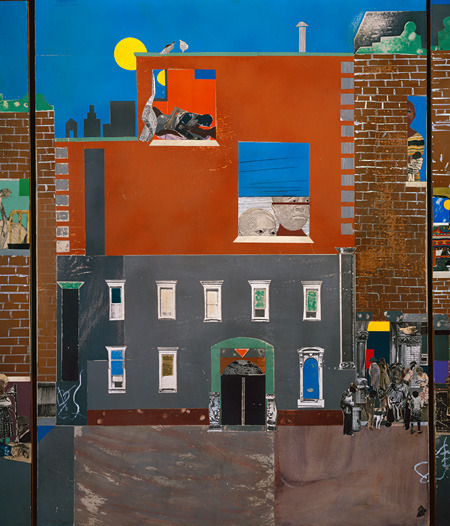
My favorite panel from Romare Bearden’s “The Block” (1971), which depicts Lenox Avenue between 132nd and 133rd streets in the Harlem neighborhood of Manhattan. (Coincidentally, I used to reside on Lenox between 131st and 132nd, so it strikes a special chord with me.)
Romare Bearden American, 1911—1988
The Block, 1971
Cut and pasted printed, colored and metallic papers, photostats, pencil, ink marker, gouache, watercolor, and pen and ink on Masonite
Overall: 48 x 216 inches; six panels, each: 48 x 36 inches
Check it out at the Met.
What are we looking at?
I do not know enough about African American history, socio-economics, and/or race politics in the 1970s (or today, for that matter) to say anything other than... we are definitely looking at Bearden's perception of all of these things as he experienced them in Harlem in '71; furthermore, these themes are fundamental and permeating to contemporary Harlem, lending modern relevance to The Block.
As a white-girl Columbia student, an example of gentrification, who spent 9 months living on the sixth-floor of a building located just one block South of Bearden's, I want to point out that we are looking at lovers and pigeons. We are looking into the stifling hot bedroom of an apartment on the sixth-floor of a brick walk-up with a black tar roof, which is a special kind insulation: too hot in the Winter and hot-as-hell in the Summer. We are looking into a moment of escapism from the oppressive heat, noise (seriously, it may be the noisiest street in Manhattan), and stress of Lenox Avenue. We are looking at a group congregating on the sidewalk, surely in part because no one stays inside their apartment when it is cooler outside. (With many buildings still not rewired/approved for in-window air-conditioning units, this continues to be a problem today. My apartment reached 110 degrees on various days last July...) We are also looking at socialization, the kind that does not require any particular reason. We are looking at pigeons because every brick building on Lenox comes complete with a pigeon roost and incessant cooing beginning at daybreak. We are looking at neighborhood voyeurs, spectators, agoraphobics, people simultaneously oppressed and liberated by their home. We are looking at graffiti on the side of a building, a sidewalk, a skyline, the sun and the moon.We are looking at a collage not just of mediums, but of subjective sensory experiences and memories. We are looking at Bearden's Harlem, but we are also looking at my Harlem, the Harlem that belongs to anyone who has lived there (especially along Lenox because streets are so unique), and we are also looking at the Harlem that any passerby would see. It all depends on where you choose to situate your body or your gaze on The Block.
No comments:
Post a Comment